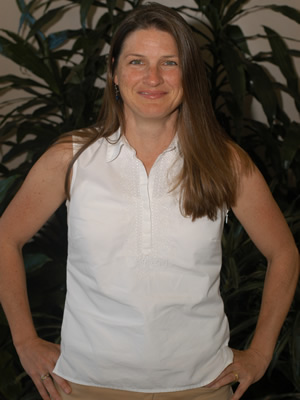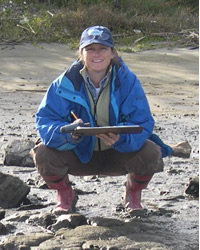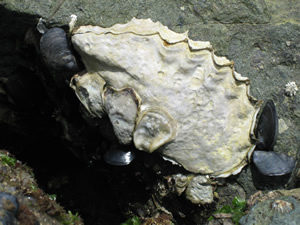Native Come Back
Almost-Extinct Native Oyster Could Become a Delicacy
March 17, 2009
By Russ L. Hudson

Danielle Zacherl
Marine ecologist Danielle Zacherl's efforts to revive California’s native oyster, the Olympia — Ostrea lurida — could conceivably lead to the restoration of the Olympia fishery along the Southern California coast.
Fished to near-extinction by the 1930s, then further damaged by sulfite pollution from paper mills, Olympias could once again become a targeted food source and a new profit center for fisheries.
“They are smaller and slower-growing than the ubiquitous Japanese and Pacific oysters deliberately introduced to our waters by fishermen in the 1910s through the 1950s,” said the assistant professor of biological science, “ but connoisseurs consider them meatier and more savory, or umami, the new word for that taste from the Japanese.
“Their size and growth rate means they won’t be harvested on as large a scale as the Pacific species,” Zacherl pointed out, “but they could become a specialty dish.”
Zacherl focuses on establishing where Olympias live and how they thrive, and she and her team of student researchers came up with at least one surprise already. They located natural beds of O. lurida in and below muddy tidal flats in Newport Bay that the Department of Fish and Game didn't know existed. Fish and Game is a traditional source of such information for environmental and development planning.
Students Search for Clues

Zacherl records data during a trip to the low-tide mudflats in Newport Bay
Former student Erin Seale (B.A. biological science-marine biology '07) conducted a search of decades-old surveys of sea life along the Southern California coast. She found records establishing that beds of Ostrea Conchaphila — another name used for Ostrea Lurida by some scientists who consider them the same species — were once found in local waters, including Newport Bay in Orange County. Her research subsequently earned her the 2007 Pollak Library Prize for undergraduate research papers and projects.
Seale then waded through mud flats at low tide to place special ceramic tiles attractive to oyster larvae in areas where oysters typically settle. Seale monitored the tiles for most of a year, until she was certain the larvae were settling in the nearby bay. Seale's work showed Zacherl she could focus her research within easy commuting distance of the campus.
Zacherl was prepared to go miles up or down the coast if necessary: “In earlier times, before over fishing and pollution, lurida’s habitat went all the way down to Baja,” she pointed out. “We weren’t certain where we’d find them thriving.”
“This is good to know,” said Jeff Stoddard, Department of Fish and Game wildlife biologist and preserve manager in the Newport Bay, about the discovery of the native oyster in his territory. “We didn't know they were there. This is valuable information, especially when development is planned in the future, so that the beds can be protected and aren’t damaged or silted over.”
Two to four monthly treks through the muddy intertidal zones and 10 scuba dives over the last three years allowed Zacherl’s group to identify many oyster beds throughout Newport Bay.

Such smaller Ostrea lurida make their homes on the shell of a much larger Pacific oyster.
Lily Sam, a senior biology major, took over where Seale left off. “I’m still placing and monitoring the tiles,” Sam said, but the job has expanded from simply establishing that the lurida larvae are present. Sam places the tiles in multiple intertidal locations in the bay to determine which locations attract the most oysters.
“I am interested in studying this species’ settlement patterns over time throughout one estuary,” Sam said, “I worked with undergraduates from Dr. Zacherl's lab to monitor settlement at six sites during the last several months in Newport Bay using ceramic settlement tiles attached to PVC tees to hold them in place. The ambient water temperature was continuously monitored by attaching small electronic data loggers to my settlement tees.
“I am also interested in studying the settlement of the oyster larvae compared to tidal height,” Sam added. “It would be useful to know if there was a particular depth or height from the bottom at which the oysters prefer to settle. Knowing the best locations for the oysters would make it easier for those who are performing restoration projects to efficiently collect the maximum amount of larvae.”
A preliminary study early in Zacherl's project deployed settlement tiles during scuba dives for data deeper in the bay, about six to 10 feet deeper than the lowest tide, Sam said, but it wasn’t as effective as they had hoped.
“Results showed our data could not separate the effects of tidal height — that is, how the depth of the water changes with the tides — and the distance from the bottom, so once again, PVC tees were set out by hand on and near a mud flat at varying distances from the bottom that could be reached without scuba gear, as well as at various tidal heights.” The tide differential in the bay is about a seven feet. Sam planned her walks across the flats to place tiles to coincide with particularly low tides.
Periodically Sam brings the tiles to the lab and counts the tiny young oysters under a microscope. Sam’s data indicates oysters prefer to settle at deeper tidal heights and close to the bottom.
Researching Need for Further Study
Zacherl and her team follow a process familiar to many researchers: establish the need for more study, then go after larger grants to do a full study. She currently works under a $5,000 California State University Faculty Awards grant but, "Right now, I'm thinking of grant ideas with the National Science Foundation, UC California Sea Grant and the Nature Conservancy," Zacherl said. She doesn't leave out the possibility of an industry grant if the idea of farming the small-but-tasty oyster catches on. There may be reason to be optimistic.
Olympias seem to attract little attention in Southern California, as far as research and re-establishing habitat, which could leave Zacherl somewhere in front of the pack as far the recent surge of interest in shellfish. In a recent report by the National Oceanic and Atmosphere Administration National Marine Fisheries Service, every site mentioned for study and/or restoration was in the far Northern California-Oregon-Washington area.
René E. Lavoie of the Bedford Institute of Oceanography in Canada believes "there may just be a market for a reliable supply of very young, very small, deep cup, meaty ... oysters out there." Although the Pacific oyster dominates now, he said, environmentalists and the Native American coalition called First Nations of the United States and Canada are pushing to preserve the native oyster and keep waters clean for them so they can thrive. They have formed the Aboriginal Aquaculture Association, and the Audubon Society, the Monterey Bay Aquariums Seafood Watch and EcoFish are supporting efforts to protect oyster habitats.
Both commercial and environmental concerns motivate these groups, Lavoie writes in ""Oyster Culture in North America History, Present and Future Oysters' ability to purify ocean waters captures their interest, Lavoie said. Even smaller oysters, like O. lurida, filter up to 40 gallons a day as they sieve seawater for food. Oyster beds also stabilize sea floor sediment and provide habitat for other marine life.
Carlsbad Aquafarms expressed interest in farming the Olympia oyster. Finding heretofore unknown natural O. lurida beds in Southern California could give Aquafarms a leg up in a Southern California market, said Matt Steinke, Carlsbad's logistics and production manager. “We certainly would be interested in them, for a delicacy market, and we’re sure we can get the Department of Fish and Game permits to grow them. So, we are interested in the results of Dr. Zacherl’s research. If it looks like they can be seeded and thrive on farms here, we might take it on.”
The oyster's habitat range interests Zacherl, as well, so she studies the evolutionary history of the oyster. It is possible it is the same species as an oyster common in Mexico, Ostrea conchaphila. Scientist debate whether the two are related or are the same. Recent findings, about to be published in the Journal of Shellfish Research, Zacherl said, support the long-held belief by many scientists in the Pacific Northwest that the Olympia is a different species, Ostrea lurida.
Collaborative Efforts
Zacherl recently began a collaboration with Sarah Gilman, a marine ecologist at Claremont University. “We are exploring how well Olympia tolerates heat and cold extremes relative to non-native oysters in Newport Bay. That can give clues to how well it can withstand changes as the seas’ currents and temperatures change” in the Earth’s global warming cycle.
"We don't know all we need to yet, but in time we'll know if it's able to successfully compete for survival with other oyster species under climate change scenarios." Gilman, Zacherl and Zacherl's student team will continue to collect such data, Zacherl said, with one "generation" of students passing the baton to the next. Sam illustrates that dynamic.
"I got started in marine biology by accident," Sam recounted. "I was accepted into the Southern California Ecosystems Research Program and we were required to choose a faculty adviser to work with. I never intended to get into marine biology, but Erin approached me and asked me to take over her study. I did, I got hooked, and I have had an interest in marine invertebrates ever since!"
Sam added, "Danielle has been a wonderful mentor. She helped me with several projects and opened up opportunities for me, and now I have a great internship in the marine biology lab at the L.A. County Sanitation District because of the great learning experiences I had in Danielle’s lab and through SCERP."
Sam hopes graduate school is in her near future. She plans to major in marine biology.
The Department of Fish and Game provides access to sensitive Newport Bay areas, and Newport Bay Naturalists and Friends, an activist organization of citizens, scientists and educators who monitor activities in the bay that affect its ecology and who coordinate bay activities with governmental agencies such as the DFG, are in support of Zacherl and her team's research. The group, which has collected scientific and historical records on the bay since the 1960s, has a great deal of information Zacherl accesses.
Zacherl, a member of Cal State Fullerton's faculty since 2003, received her doctorate in evolution and marine biology from UC Santa Barbara. Her postdoctoral work was with near-shore marine organisms.
Related Story:
Zacherl Studies Whelk Larvae for Clue to Marine Life Dispersion Patterns

